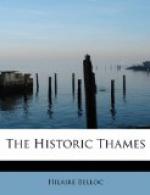Mandeville holds Tower, 83.
Manors,
in monastic hands in Thames Valley, 124-126;
English, probably Roman in origin, certainly
Saxon, 141, 142;
royal lapse of, 144;
mutability of ownership in, after Dissolution,
161-169.
Matilda, fealty sworn to, at Windsor, 70.
Medmenham, Priory of, 109.
Mill, family of, succeeds Hobys at Bisham, 164.
Monasteries, system of, 91-93.
Monastic foundations on Thames, list of, 122, 123.
Monastic possessions in Thames Valley, list of, 125-126.
Monastic system, 108, 116, 117, 127, 148, 150.
Montlhery, originally dominated Paris as Windsor London, 67.
Mont St. Michel, connection with Cholsey, 166.
Morgan, first known of the Williamses, 152.
“Mota de Windsor,” 70.
Mortimer holds Wallingford, 60.
Municipal system,
English, different from that of other
countries, 170-175;
Roman, 171;
in Roman Britain, 172.
Naseby, battle of, women massacred after, by Puritans, 88, 89.
Norman Conquest, 52, 82, 93.
Normandy, modern boundaries of, fixed by Diocletian, 33.
Nuneham Morren, example of parish with special water front, 11.
Observants at Richmond, 93.
Ock, River, original marsh at mouth of, 8.
Offa, Wallingford mentioned under, 37.
Oilei builds Osney, 105.
Old Windsor, 69, 70.
Oligarchy rose on ruins of Catholicism, 140-152.
Orby obtains Chertsey, 164.
Osney, Abbey of, at Oxford, 105;
loot of, by Henry VIII., 106;
appearance of, before Dissolution, 112,
113.
Owen obtains Hinksey, 166.
Oxford, 22, 31, 53, 58, 86, 87, 106, 183-186.
Oxford Street, Roman military road into London, 68.
Pangbourne, ford at, 34;
held of Reading Abbey, 167;
fate of land of, 167.
Paris, dominated by Montlhery as London by Windsor,
67;
an example of fortification following
residence, 77.
Parishes, shape of, 8, 11.
Penda, his opposition to Christianity, 51.
Peregrine Hoby, 164.
Perrots obtain Hinksey, 166.
Philiphaugh, battle of, massacre of women after, by Puritans, 89.
Place names,
on the Thames, 30, 32, 33;
Celtic, rare in Thames Valley, 30;
Roman, disappeared in Thames Valley, 32.
Pole, his estimate of population, 196.
Population,
of Abingdon and Reading, typical of change
in nineteenth century,
198;
of Oxford in early times, 56, 57.
Prices and values at time of Dissolution compared
with modern,
130-136.
Priory of Medmenham, 109.
Puritans, their massacre of the women after battle
of Philiphaugh, 88,
89.
Radley, fate of land of, 165, 166.




